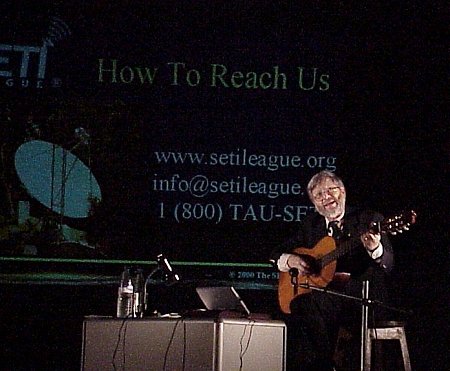|
|
Membership Services General Info Financial Info Activities Awards Coordinators Director's Info Members' Info Policies Forms Publications Official Publications Director's Publications Ask Dr. SETI ® Fiction Non-Fiction Reviews Reading Lists Technical Support Systems Antennas Amplifiers Receivers Accessories Hardware Software Press Relations Fact Sheets Local Contacts Editorials Press Releases Photo Gallery Newsletters Internet Svcs |
|
 Tune In The Universe! by SETI League executive director Dr. H. Paul Shuch Excerpt: Sing a Song of SETI
Dr. SETI, the blatant exhibitionist who inhabits my body, has been called a cross between Carl Sagan and Tom Lehrer (he sings like Sagan, and lectures like Lehrer). Arguably the most public side of my persona, Dr. SETI travels around the world with a laptop computer, an acoustical guitar and a stack of slides, singing the praises of radio astronomy and SETI to the tune of some forgettable filks. Perhaps you've seen him on TV. So what's a filk? Filk, a perversion of the word folk, is the traditional music of science fiction fandom, sung at SF conventions around this world (and possibly others). The word started off as a typographical error in a Con program announcement, and caught on. An outgrowth of the American folk music revival of the 'sixties, filks are often written as parodies to existing melodies, and are frequently accompanied by guitar. The earliest example which I remember (there probably are earlier ones) actually predates my knowledge of the term filk: Dr. John Boardman's humorous 1961 "Asteroid Light" space chanty, sung to the tune of the popular "Eddystone Light" sea chanty. Filks generally deal with SF, fantasy, technology, space travel, and related scientific themes. Dr. SETI's songs are examples of the sub-species known as science filk, in which the lyrics need to be true to scientific fact, as we understand it. Dealing as they do with SETI and radio astronomy, these songs are intended to pay tribute to the giants of SETI: those individuals and facilities which have contributed to today's understanding of the cosmos, and our place within it. A sample lyric:
My satellite antenna is pointed at the sky,
Dr. SETI's roots go back to my civil rights days. As a freedom rider, I always carried a guitar, as much as a shield against billy clubs as to accompany "We Shall Overcome." (A few years later, when rock musicians began smashing guitars on-stage, I wondered as to their political motives.)
A quarter century after I had forgotten even Les's name, my second wife, Dr. Janet Sherman, played a tape which reintroduced me to filk. One rather husky, strident voice sounded vaguely familiar. "I know that woman," I told Janet. "Of course you do. That's Leslie Fish. She's famous." "No," I protested. "You don't understand. I know that woman." I couldn't say from where, but there's no mistaking a voice, or a guitar style. "Sure you do," said Janet, humoring me. And that was the end of the conversation. A year later, one Leslie Fish was the filk guest of honor at Balticon, the annual Baltimore science fiction convention, and Janet and I went to hear her. I had listened to quite a few Leslie Fish tapes by then, but still couldn't place where I'd heard that voice. Leslie gave a guitar workshop; I sat in the front row. She fingered a twelve-string with a familiar style. During the question period, Leslie dialogued with a young fan about neck width. "I used to have a Gibson Hummingbird," she told the fan, "and it had a wide neck. That's a bitch for someone with small hands." And the light bulb lit up above my head. "That Gibson Hummingbird," I asked after the workshop, "was it red?" "Why, yes." "Did you have it with you at DuPont Circle on August 28, 1963?" Leslie Fish looked at me quizzically for a long time. Then she blurted out, "Howie?" These days the only one in the world allowed to call me by my first name is my mother. But I was willing to make an exception. "Les!" I responded, and we hugged. I winked at Janet, feeling vindicated. By now I was already involved in SETI, and starting to write Dr. SETI's repertoire. It was Leslie Fish who came up with the moniker, at a World Science Fiction Convention. It seemed a suitable stage name. Steve Carver, K5PT, the volunteer intellectual property counsel for The SETI League, helped us turn it into a registered service mark. For her part, Leslie Fish and her publisher, Random Factors, have graciously licensed her various melodies, royalty-free, for use in my SETI songs. It is their small contribution to SETI science, for which I am extremely grateful. If Dr. SETI only sang and strummed, he'd be just one more starving artist. Fortunately, I've been able to expand my sphere of influence beyond the music of the spheres. I started a column in SearchLites, The SETI League's quarterly newsletter, titled "Ask Dr. SETI." It's technical advice to the star-struck, which makes Dr. SETI what the British call an 'agony aunt.' That's why, when UK amateurs Ken Chattenton and Trevor Unsworth detected their now-famous candidate signal on May 10, 1996, their reaction (as documented in the Introduction) was "it's time to Ask Dr. SETI."
 Old Dr. SETI, on stage in India
|

